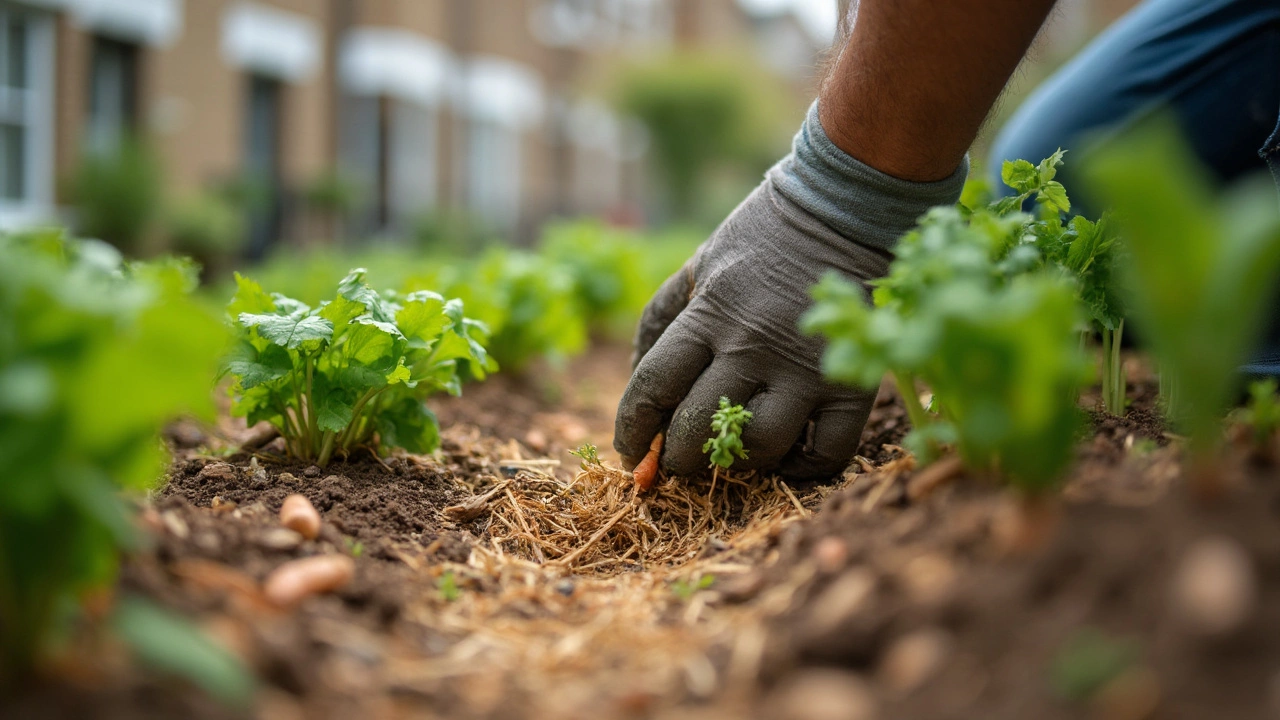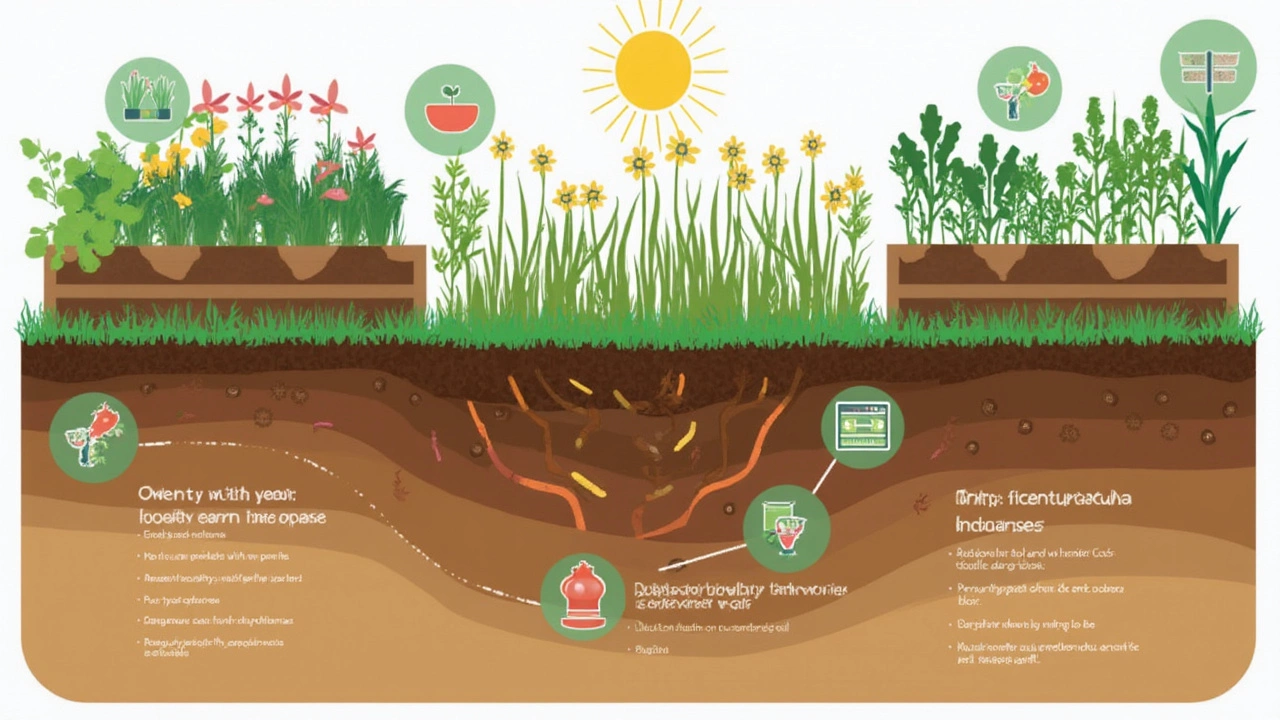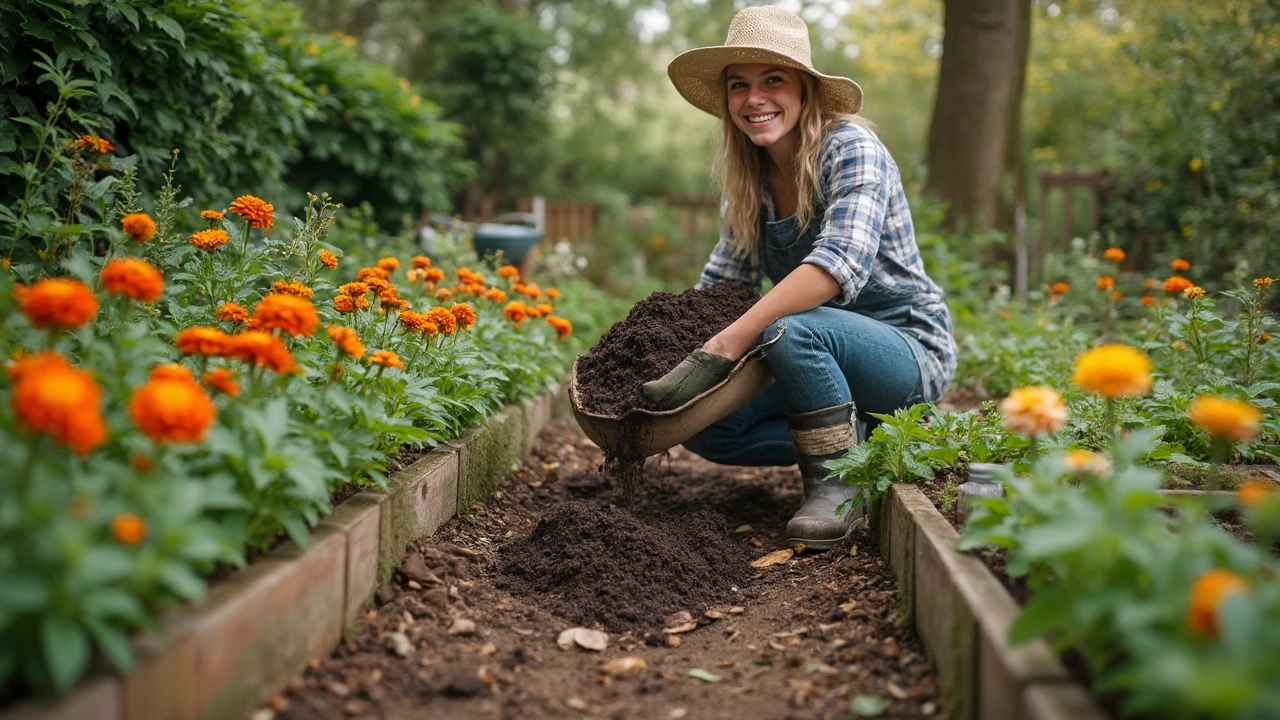Great soil grows great plants—it's that simple. But most yards and gardens start out with dirt that's tired or just not good enough for strong roots. That's where soil enrichment comes in. If you've ever wondered why your tomatoes look sad or your lawn seems patchy, the answer often hides underground.
First thing: Figure out what your soil actually needs. Just guessing doesn't cut it. Pinch a handful of soil—does it feel gritty, sticky, or like powder? Each texture has its own issues and fixes. A simple test kit from the local garden center shows what nutrients are missing. Armed with that info, you can target your efforts instead of playing garden roulette.
Skip the instant fixes. Healthy soil is about adding in the good stuff, like organic matter and nutrients that feed worms and microbes. Think kitchen scraps, fallen leaves, even grass clippings—these get broken down into rich compost that your plants love. It smells earthy and looks dark and crumbly—way different from tired backyard dirt.
- Understanding Your Soil's Needs
- Easy Ways to Add Organic Matter
- Composting: The Everyday Solution
- Choosing the Right Fertilizer
- Solving Common Soil Problems
Understanding Your Soil's Needs
Your soil can be sandy, clay, silt, or a mix, and each type needs something different to work best. About 65% of home gardens in the US have soil that’s either too sandy or too much clay, which often means poor plant growth. If you want healthy plants, you need to know what’s happening below the surface.
The easiest start is the squeeze test. Grab a handful of moist soil and give it a squeeze:
- If it falls apart, you probably have sandy soil, which drains fast but dries out quickly.
- If it stays clumped and feels sticky, it’s clay-heavy. Clay holds water, but roots have a hard time pushing through it.
- If it’s somewhere in the middle and crumbles apart, you’re in luck. That’s loam, the sweet spot for most plants.
But texture is only part of the story. Your soil could be missing nutrients or have pH problems. Instead of guessing, grab a $10 soil test kit from a garden center. You’ll get a report on pH (acid or alkaline), major nutrients like nitrogen, phosphorus, potassium, and sometimes even minor nutrients.
| Soil Test Metric | Ideal Range for Most Plants |
|---|---|
| pH | 6.0 – 7.0 |
| Nitrogen (N) | Medium to High |
| Phosphorus (P) | Medium |
| Potassium (K) | Medium to High |
Soil pH affects what nutrients your plants can actually use. For example, if your pH is out of whack, adding more fertilizer often doesn’t fix the issue. Get that pH in line first.
Another way to spot trouble: look at your plants. Yellow leaves? Might be a nitrogen problem. Purple-tinted leaves? That’s often a sign of low phosphorus. Patchy growth can mean poor drainage or compaction.
The bottom line: Don’t just throw products at your dirt. Understand what you’ve got first, so every scoop of compost, mulch, or fertilizer hits the mark. Soil enrichment works best when you target your fixes to what your soil actually needs.
Easy Ways to Add Organic Matter
If you want healthy plants, getting more organic matter into your soil is a must. This isn't about expensive products. The stuff you already have—kitchen scraps, lawn clippings, and fall leaves—works like magic when treated right.
Start with compost. A well-made compost pile is basically a recycling station for food scraps and yard waste. Toss in things like banana peels, coffee grounds, shredded newspaper, vegetable trimmings, grass clippings, and dried leaves. Avoid meat, dairy, and greasy foods since they attract pests. Mix things up every couple of weeks to keep it cooking. In a few months, you get black, crumbly stuff that smells a bit like fresh earth. That’s your jackpot.
- Spread a half-inch layer of finished compost over your garden beds twice a year. That’s all you need to feed most plants and keep your soil microbes happy.
- Try mulching with shredded leaves or grass clippings. Leave the mulch on top so it slowly breaks down and works its way into the soil.
- Cover crops—like clover or alfalfa—are easy to grow and then work straight into the soil. They boost nitrogen and help stop erosion.
Worried about what works best? Here’s a quick look at common ways to get organic matter into your soil and how fast they actually help:
| Amendment | How Fast It Helps | Extra Benefits |
|---|---|---|
| Compost | 1–3 months | Boosts microbes & water-holding |
| Grass Clippings | 1 month if thin layer | Free & easy to spread |
| Fallen Leaves | 4–12 months | Good for slow, steady change |
| Cover Crops | Full season | Prevents weeds, adds nutrients |
This isn’t just about making your plants look good. More organic matter means healthier roots, better water drainage, and fewer headaches from pests and disease. If there’s one move you make for soil enrichment, let it be this: keep adding organic matter, and don’t stop once you see results. It only gets better from here.

Composting: The Everyday Solution
Turning kitchen scraps and yard waste into compost is probably the easiest way to boost your soil. Composting doesn’t need fancy bins or weird gadgets—just a spot to pile stuff up and a little time. The key is mixing the right stuff together and giving it a bit of attention now and then.
The magic combo is called browns and greens. Browns are things like dried leaves, shredded newspaper, and cardboard. Greens are your fruit peels, vegetable trimmings, coffee grounds, and grass clippings. A good mix (about two parts brown to one part green) keeps the pile healthy and helps it break down faster.
It’s not just about getting rid of leftovers. Compost adds a ton of value:
- Boosts soil structure, so roots can breathe and grow strong
- Adds slow-release nutrients, giving plants steady food
- Helps the ground hold water, so you water less
- Feeds earthworms and helpful microbes for better soil health
Numbers don’t lie. The U.S. Environmental Protection Agency says food scraps and yard waste make up 28% of what we toss in landfills. Composting cuts that down and gives you free soil food.
| Material | Type | Compost Value |
|---|---|---|
| Banana peels | Green | Lots of potassium |
| Dried leaves | Brown | Bulks up pile, adds carbon |
| Coffee grounds | Green | Great nitrogen source |
| Cardboard | Brown | Breaks up wet clumps, adds bulk |
Want a quick list to start? Here’s what you can and can’t toss in a backyard pile:
- Soil enrichment happens with stuff like veggie scraps, eggshells, coffee filters, and old leaves
- Skip meat, dairy, oil, and pet waste—they attract pests and stink things up
- Chop big pieces smaller so they break down quicker
- Turn your pile every week or two for faster compost
“Compost is the single most important supplement you can give your garden soil.” – Rodale Institute
Get your pile going and watch your garden thrive. It’s an easy win for greener, healthier soil without buying bags of mystery fertilizer.
Choosing the Right Fertilizer
Picking the right fertilizer isn’t about grabbing the bag with the flashiest label. It’s way simpler once you know what your soil is missing. Gardeners who use the right blend see stronger plants and bigger harvests, with less hassle from diseases or bugs.
Here’s the deal: all fertilizers show three numbers, like 10-10-10. These stand for nitrogen (N), phosphorus (P), and potassium (K). Each does a different job. Nitrogen gets leaves green and growing, phosphorus drives roots and flowers, and potassium toughens plants against drought and disease.
- Go for high-nitrogen if your grass is pale or your lettuce isn’t growing fast.
- Pick higher phosphorus if you’re planting seeds or want better fruit and blooms.
- Pump up the potassium if your plants look weak or easily tip over.
Organic fertilizers—like composted manure, worm castings, or bone meal—break down slower than synthetics but feed microbes and help the soil long-term. Synthetics work fast and are easy to control, but they can harm worms or run off into creeks if you overdo it.
| Fertilizer Type | Main Use | Release Speed | Good For |
|---|---|---|---|
| Compost (organic) | Boosts overall soil health | Slow | All plants, ongoing care |
| 10-10-10 (synthetic) | General nutrient boost | Fast | Lawns, veggies in spring |
| Bone Meal (organic) | Root & bloom boost | Slow | Bulbs, flowers, tomatoes |
| Fish Emulsion (organic) | Keeps leaves green | Fast | Leafy greens |
| Granular Potash (synthetic) | Strengthens growth | Medium | Root crops, fruit trees |
Don’t overdo it! Too much fertilizer—organic or not—can burn roots or wash away, leaving you with nothing but headaches. Always follow the directions on the label and spread evenly. Test again after a few months so you keep your soil enrichment game strong. Remember, picking the right fertilizer is key for soil that stays rich and plants that don’t quit.

Solving Common Soil Problems
Even the best efforts can run into problems—compacted soil, poor drainage, or stubborn weeds that never give up. The trick is spotting the real issue and tackling it in a straightforward way.
Heavy, clay-packed soil makes it tough for roots to breathe or drain water. You’ll know it if rainwater pools on the surface or if your garden shovel bounces back at you. Mixing in organic matter (like finished compost or bagged manure) helps lighten up the soil, letting water and air move more freely. Sandy soil is the opposite: water drains away too fast, and plants can dry out or go hungry. Adding organic stuff here helps soak up moisture and hold nutrients where roots can grab them.
Check out this quick table to see what you’re up against and what usually works:
| Problem | Sign | What Helps |
|---|---|---|
| Compacted Soil | Hard to dig, water pools | Add compost, use a garden fork/aerator |
| Poor Drainage | Roots rot, soggy areas | Mix in grit, raise beds, more organic matter |
| Low Nutrient Levels | Pale leaves, slow growth | Apply soil enrichment like compost or balanced fertilizer |
| High Weed Pressure | Unwanted plants everywhere | Use mulch, hand-weed, avoid turning soil too much |
| Too Acidic/Alkaline | Struggling crops, odd leaf colors | Add lime for acid soil, sulfur for alkaline |
Sometimes it’s about timing. For example, don’t add fertilizer right before heavy rain; it’ll just wash away. Mulch can stop weeds and keep the ground steady, but keep it clear of plant stems so you don’t cause rot. If you’re stuck with a repeated issue, sometimes soil in that spot just isn’t right for some crops—try rotating what you grow or popping a raised bed on top instead of fighting a losing battle.
Soil problems happen to everyone, not just beginners. Watch your plants—yellow leaves or stunted growth mean something’s up below. Fixing the basics keeps surprises to a minimum and lets you focus on enjoying your garden instead of battling it every weekend.
